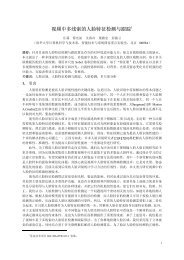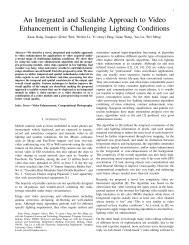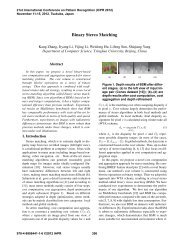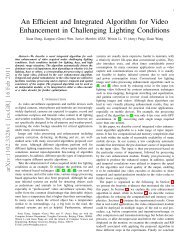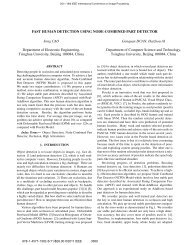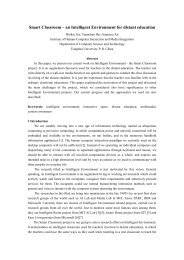Human Detection in Video over Large Viewpoint Changes
Human Detection in Video over Large Viewpoint Changes
Human Detection in Video over Large Viewpoint Changes
You also want an ePaper? Increase the reach of your titles
YUMPU automatically turns print PDFs into web optimized ePapers that Google loves.
Reca l<br />
Reca l<br />
Reca l<br />
Reca l<br />
Reca l<br />
Reca l<br />
<strong>Human</strong> <strong>Detection</strong> <strong>in</strong> <strong>Video</strong> <strong>over</strong> <strong>Large</strong> Viewpo<strong>in</strong>t <strong>Changes</strong> 1257<br />
0.95<br />
Test Sequence 1 (ours, 2420 frames, 591 annotations)<br />
0.9<br />
Test Sequence 2 (ours, 1718 frames, 1927 annotations)<br />
0.9<br />
0.85<br />
0.85<br />
0.8<br />
0.8<br />
0.75<br />
0.75<br />
0.7<br />
0.05 0.1 0.15 0.2 0.25 0.3<br />
FPPI<br />
0.75<br />
Intra-frame CF + Boost<br />
Intra-frame CF + EMC-Boost<br />
I 2 CF + EMC-Boost<br />
S05 (PETS2007, 4500 frames, 17067 annotations)<br />
0.7<br />
Intra-frame CF + Boost<br />
Intra-frame CF + EMC-Boost<br />
I 2 CF + EMC-Boost<br />
0.65<br />
0.2 0.4 0.6 0.8 1 1.2 1.4 1.6 1.8 2<br />
FPPI<br />
0.8<br />
Seq. #1 (ETHZ, 999 frames, 5193 annotations)<br />
0.7<br />
0.65<br />
0.75<br />
0.7<br />
0.65<br />
0.6<br />
0.6<br />
0.55<br />
0.55<br />
0.5<br />
0.5<br />
0.45<br />
Ess et al.<br />
Schwartz et al.<br />
0.45<br />
Intra-frame CF + Boost<br />
Intra-frame CF + EMC-Boost<br />
I 2 CF + EMC-Boost<br />
0.4<br />
0.35<br />
Wojek et al.(HOG, IMHwd and HIKSVM)<br />
Intra-frame CF + Boost<br />
Intra-frame CF + EMC-Boost<br />
I 2 CF + EMC-Boost<br />
0.4<br />
0.2 0.4 0.6 0.8 1 1.2 1.4 1.6 1.8 2<br />
FPPI<br />
0.75<br />
0.7<br />
0.65<br />
0.6<br />
Seq. #2 (ETHZ, 450 frames, 2359 annotations)<br />
0 1 2 3 4 5 6<br />
FPPI<br />
Seq. #3 (ETHZ, 354 frames, 1828 annotations)<br />
0.9<br />
0.8<br />
0.7<br />
0.55<br />
0.6<br />
0.5<br />
0.45<br />
Ess et al.<br />
Schwartz et al.<br />
0.4<br />
Wojek et al.(HOG, IMHwd and HIKSVM)<br />
Intra-frame CF + Boost<br />
0.35<br />
Intra-frame CF + EMC-Boost<br />
I 2 CF + EMC-Boost<br />
0 0.5 1 1.5 2 2.5 3 3.5 4<br />
FPPI<br />
0.5<br />
0.4<br />
0.3<br />
Ess et al.<br />
Schwartz et al.<br />
Wojek et al.(HOG, IMHwd and HIKSVM)<br />
Intra-frame CF + Boost<br />
Intra-frame CF + EMC-Boost<br />
I 2 CF + EMC-Boost<br />
0.2<br />
0 0.5 1 1.5 2 2.5 3 3.5 4<br />
FPPI<br />
Fig. 6: Evaluation of our approach and some results.<br />
and VV are 18976, 19248 and 8848 respectively. The size of positives is normalized<br />
to 58 × 58. Some positives are shown <strong>in</strong> Fig. 4. We tra<strong>in</strong> a detector based on<br />
EMC-Boost select<strong>in</strong>g I 2 CF as features. Implementation details. We cluster the<br />
sample space <strong>in</strong>to 2 clusters <strong>in</strong> the 1 st stage and cluster the two sub spaces <strong>in</strong>to<br />
2 and 3 clusters separately <strong>in</strong> the 2 nd stage as illustrated <strong>in</strong> Fig. 5 (b). When do<br />
we start and stop MC/SC? When the false positive rate is less than 10 −2 (10 −4 )<br />
<strong>in</strong> the 1 st (2 nd ) stage, we start MC and then start SC after learn<strong>in</strong>g by MC.<br />
Before describ<strong>in</strong>g when to stop MC or SC, we first def<strong>in</strong>e transferred samples. A<br />
sample is called transferred if it belongs to another cluster after current round<br />
boost<strong>in</strong>g. We stop MC (SC) when the number of transferred samples is less than<br />
10% (2%) of the total number of samples.<br />
Evaluation. To compare with our approach (denoted as I 2 CF +EMC-Boost),<br />
two other detectors are tra<strong>in</strong>ed: one is to adopt Intra-frame CF learned by a general<br />
Boost algorithm like [5] [15] (denoted as Intra-frame CF+Boost) and the<br />
other one is to adopt Intra-frame CF learned by EMC-Boost (denoted as Intraframe<br />
CF+EMC-Boost). Note that due to the large amount of Inter-frame CFs,<br />
the large amount of positives and memory limited, it is impractical to learn a<br />
detector of Inter-frame CF by Boost or EMC-Boost.<br />
We compare our approach with Intra-frame CF + Boost and Intra-frame CF<br />
+ EMC-Boost approaches on PETS2007 dataset and our own collected videos,<br />
and also with [4] [20] [22] on ETHZ dataset. We give the ROC curves and some<br />
results <strong>in</strong> Fig. 6. In general, our proposed approach which <strong>in</strong>tegrates appearance<br />
and motion <strong>in</strong>formation is superior to Intra-frame CF+Boost and Intra-frame<br />
CF+EMC-Boost approaches which only use appearance <strong>in</strong>formation. From another<br />
viewpo<strong>in</strong>t, this experiment also <strong>in</strong>dicates that <strong>in</strong>corporat<strong>in</strong>g motion <strong>in</strong>formation<br />
improves detection significantly as [4].



